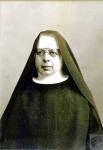Last week’s article was about the old Covington High School that was eventually replaced by Holmes High School. This article focuses on another Covington school that evolved over time – St. Walburg Academy.
The Sisters of St. Benedict, a Catholic order of women religious, arrived in the United States from Eichstadt, Bavaria in 1852. Their first foundation in the United States was at Erie, Pennsylvania. The sisters were invited to Covington by Bishop George A. Carrell in 1859. Bishop Carrell was in desperate need of sisters who could teach in the growing German-speaking parish schools in Northern Kentucky.

St. Joseph photo (left to right): St. Walburg Academy (later Villla Madonna college), St. Walburg Convent, St. Joseph Girl’s Schools, St. Joseph Church (Photos courtesy of Kenton County Public Library)
The first group of sisters to arrive in Covington were Sister Josephine Buerkle, Sister Anselma Shoenhofer and Sister Ruperta Albert. Sister M. Alexia Lechner and Sister Salesia Haus came to Covington soon thereafter. Sister M. Alexia Lechner was appointed the first superior of the Covington community. Their first assignment was to teach at St. Joseph Parish School on East 12th Street.
Initially, the Sisters of St. Benedict were housed in a small cottage on Bush Street in Covington’s eastside neighborhood. Taking a leap of faith, they began construction on a new brick convent in 1860 on East 12th Street near St. Joseph Church. The building was named St. Walburg Convent. Additions to the convent were completed in 1867 and again in 1877 to house the growing number of sisters.

Sister Walburga Saelinger
The first Covington woman to enter the order was a German immigrant named Helen Saelinger who became known as Sister Walburga. Sister Walburga was Prioress of the community from 1889 until her death in 1928. Under her guidance the order flourished.
The sisters established St. Walburg Academy in the convent building on East 12th Street in September 1863. The academy operated as an elementary school for young women. Later, a high school program was added at the academy. In 1890, a separate academy building was constructed on a lot west of the convent. This three-story brick Victorian style structure included classrooms, a library, art and music rooms and gathering spaces for the students and sisters.
Most religious orders established academies in addition to working in the parish schools. Parish schools charged little or no tuition and were primarily educating the children of immigrants and working class parents. The academies, however, tended to offer a broader range of classes including music and art. The academies typically catered to the middle class and charged a more substantial tuition than the parish schools. In this way, the academies subsidized the work the sisters were doing for the poor and immigrant children of the region.
Eventually, St. Walburg Academy was accredited by Catholic University of America, the Commonwealth of Kentucky (Class A rating) and the Southern Association (Class A rating). The first student to complete the twelve year program at St. Walburg Academy was Jennie E. Dillon who graduated in 1877. She became the first in a long line of graduates who eventually established a flourishing alumni association.
In 1903, the Sisters of St. Benedict in Covington purchased a farm in the present day City of Villa Hills. On this property, the sisters established Villa Madonna Academy, a boarding and day school for young women. The new Villa Madonna Academy building was dedicated in May 1907 and provided an elementary and secondary school curriculum. In 1916, the novitiate (training school for young women wishing to enter the order) moved from Covington to the Villa Madonna property. The motherhouse of the community followed in 1932.
Teacher education became a prime objective in Kentucky public and parochial schools following the First World War. As a result, in 1921, the Benedictine Sisters established Villa Madonna College in Villa Hills (now Thomas More College). The college was accredited by the Commonwealth of Kentucky in 1923 and was open to both sisters and laywomen. The college became co-educational in 1945. In 1928, it was decided that the Sisters of Notre Dame and the Sisters of Divine Providence would work with the Benedictines to provide one Catholic liberal arts college in the area. At that time Villa Madonna College came under the auspices of the Diocese of Covington. The college was moved from Villa Hills to the St. Walburg Academy building in Covington. St. Walburg Academy was chosen because it was centrally located for all three religious orders and was on the streetcar line.

Villa Madonna Academy, Villa Hills
As the college grew, St. Walburg Academy lost more and more space in the building on West 12 Street to the college. The Sisters of St. Benedict reluctantly voted in 1931 to close St. Walburg Academy. The academy was near and dear to the sisters’ hearts and had been part of their community tradition for 68 years. The last graduating class consisted of eight young ladies.
In 1968, Villa Madonna College moved from the old St. Walburg Academy building in Covington to a new campus in suburban Crestview Hills. On July 10 of that same year, the last Mass was celebrated in the old St. Walburg Convent. The old convent and academy/college building were demolished. St. Joseph followed a few years later in 1970. The only building left from the old St. Joseph Benedictine campus is St. Joseph School at the corner on West 12th and Scott Streets. The building is now owned by the Covington Independent School District and houses the James E. Biggs Early Childhood center.
Dave Schroeder is executive director of the Kenton County Public Library. With other well-known regional historians, James C. Claypool and Paul Tencotte, he is a co-editor of the new 450-page Gateway City: Covington, Kentucky, 1815-2015, now available at your local booksellers, the Center for Great Neighborhoods in Covington and online sellers.
























